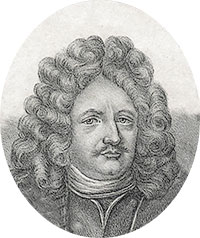
Robert Lichton (1631–1692) (a.k.a.: Leighton, Lichtoun, Lichtone, Lyton), Lord of Ulishaven, Forfarshire, Scotland and Lord of Tervik. He was a Lieutenant General in the Swedish Army and President of the Superior Court of Justice ( hovrätt) at Åbo.
Career
Robert Lichton was born in 1631 at Humsland in Porvoo parish of the Swedish Empire (now Finland). [1] He was the son of Colonel John Lichtoun of Ulishaven ( † 1636) and Catharina Gutherie. [2] When his father fell at the Battle of Wittstock during the Thirty Years' War, Robert, while still a child, inherited his estate of Tervik. [1] At the age of fifteen he entered the Swedish Army as a private and a Musketeer and participated in campaigns in Germany, Poland and Denmark. [2] In 1661 Lichton joined the Swedish House of Nobility as a nobleman. [1] He was promoted to the rank of Colonel in 1675 and created a baron. Lichton was appointed Governor of Estonia (Estland) [3] He received this honor at just age fifty in 1681 while a Major general. [1]
He rose to the rank of Lieutenant general in the Swedish army in 1685 and was appointed President of the Superior Court of Justice at Åbo just two years later. [1] At this same time he was created a Royal Counselor, titled Count and Baron of Ulishaven, Lord of Tervik and of Peraniemi. Lichton greatly distinguished himself at the Battle of the Sound. [4] At the Battle of Lund (1676), brave to the point of being foolhardy he was hit by several bullets, none of which were extracted. [2] Lichton greatly distinguished himself at the Battle of the Sound. [5]
Lichton was extremely strong and had a reputation for having a violent temper. He once had to leave the country after killing a regimental surgeon but was pardoned after paying a substantial fine. [2] In Stockholm in 1667 he attacked a Colonel Bine with sword and pistol, for which he was arrested, but later was allowed to quietly go free with no formal charges. [2] He was made a count by King Charles XI of Sweden in 1687. The King attended Lichton's funeral in person in 1692. [5]
Scottish heritage
Although born in Sweden Robert identified himself as Scottish. Before Robert was born his father, John Lichton, found himself in financial difficulties owing to his own father's debts. [6] He sold his lands of Ulishaven in Forfarshire to Sir David Carnegie of Kinnaird for £40,000 Scots and paid his father's creditors. [6] He saw an opportunity in becoming a Mercenary for Gustavus Adolphus of Sweden to fight in the Thirty Years' War. [6] John Lichton emigrated to Sweden in 1614 where he began his career there as an Ensign in a cavalry regiment. [7]
Sometime after 1675 (as he was at the time a colonel) He petitioned for a "birth brief" to allow him to register his arms with the Lord Lyon King at Edinburgh, which he did. [a] His arms were: Argent, a Lion Rampant gules, armed and langued azur; crest a palm tree vert; motto: "Per adversa virtus" (courage through adversity). [8] His change in motto from the old "Licht On" was probably in reference to his father's restoring the fortunes of this house. [8]
Family
He was apparently married but had no male issue.
Notes
References
- ^ a b c d e Clarance F. Lichton, Memorials of the Leightons of Ulishaven (Usan) Forfarshire, Part I A.D. 1260–1518 (London: The Electric Law Press, 1912-1931), p. 85
- ^ a b c d e Ernst Ludwig Fischer; J Kirkpatrick, The Scots in Sweden; being a contribution towards the history of the Scot abroad (Edinburgh: O. Schulze & Co., 1907), p. 131
- ^ George A. Sinclair, 'The Scottish Officers of Charles XII', The Scottish Historical Review, Vol. 21, No. 83 (Apr., 1924). p. 181 n. 1
- ^ The nobilities of Europe ed. Marquis de Ruvigny (London: Melville, 1909), p. 108
- ^ a b The nobilities of Europe, ed. Marquis de Ruvigny (London: Melville, 1909), p. 108
- ^ a b c Clarance F. Lichton, Memorials of the Leightons of Ulishaven (Usan) Forfarshire, Part I A.D. 1260–1518 (London: The Electric Law Press, 1912-1931), p. 83
- ^ Clarance F. Lichton, Memorials of the Leightons of Ulishaven (Usan) Forfarshire, Part I A.D. 1260–1518 (London: The Electric Law Press, 1912-1931), p. 84
- ^ a b c Clarance F. Lichton, Memorials of the Leightons of Ulishaven (Usan) Forfarshire, Part I A.D. 1260–1518 (London: The Electric Law Press, 1912-1931), p. 86